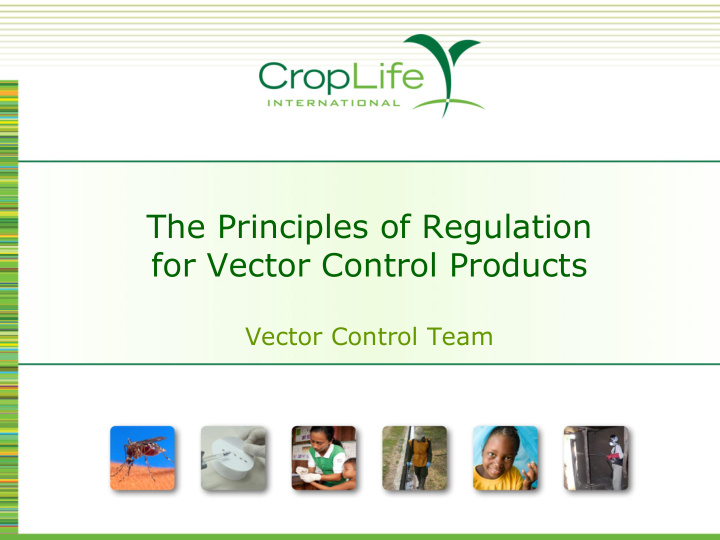



The Principles of Regulation for Vector Control Products Vector Control Team
Contents 1. The global challenge to Human Health and benefits of Vector Control technology 2. Regulation as the key to addressing the challenge 3. The Principles of Regulation Societal expectations of regulation Key recognised regulatory principles Best practices for effective registration 4. Proposals for continuous improvement
Human health faces huge challenges • Risk of disease transmission by insects is increasing - accelerated by climate change and urbanisation • The world population is set to exceed 8 billion by 2030 • 2.5 billion people at risk of contracting dengue • > 500 million cases of malaria, >750,000 deaths each year
Vector Control is at the heart of overcoming these challenges Maximising Benefits of Current Products Ensuring best practices for handling, application and use are observed Developing New Products An active pipeline of Public Health insecticide active ingredients and products is needed to meet future vector control needs Tackling Insecticide Resistance Promoting the use of existing resistant management tools and strategies
Vector Control is a vital part of the solution These challenges require the private and public sectors to confront this head on and together
Regulation is key to addressing these challenges
Regulation is an imperative It should be both a stimulant and a safeguard, working in the service of society, Public Health and Vector Control solutions. solutions Promoting investment in new solutions Assuring safety and sustainability Shared responsibility and compliance Timely access to technology
Regulation of Vector Control Products Vector Control products play an important role in society, but their benefits and regulation are poorly understood Under the International Code of Conduct Governments have the overall responsibility to regulate the availability, distribution and use of Vector Control products in their countries and to ensure the allocation of adequate resources for this mandate Regulation can be the basis for good standards and practices and thus the foundation for societal trust, confidence and capacity building
A global solution for a global challenge Regulation of Vector Control products varies enormously around the world, reflecting the importance of healthcare to society, political priorities, and economic development. So how do we satisfy the needs of our societies and meet the global challenges of the future? CropLife has looked at the standards and practices in operation today and put together ‘The Principles of Regulation’ in support of good regulation globally
The Principles of Regulation Societal expectations of regulation • Key recognised regulatory principles • Identified best practices for effective registration •
Societal expectations of regulation
Societal expectations of regulation Protective – clear protection goals that form a basis for balanced decisions which assess use (risk and benefits) Implementable – an understandable process built around a common framework builds trust and creates opportunities for workshare &/or capacity building Informed – decisions based on evidence using a common framework which extends understanding and capabilities around the world Enabling – process that allows access to technology whilst meeting protection goals Enforceable - shared responsibility for post-approval monitoring and compliance
8 Key recognised regulatory principles 1. Sound policy framework to ensure high standards of use and protection for human health and the environment 2. Quality data and transparency of regulatory process, whilst providing protection of regulatory data safe- guarding confidential business information and intellectual property 3. International harmonization wherever possible, but always taking into account local needs and conditions 4. Scientific principles and use assessment (risk/benefit)
8 Key recognised regulatory principles 5. Responsibilities of each party throughout the production and supply chains as well as commitments to responsible action 6. Compliance monitoring system and an active response process to manage adverse incidents 7. Process to ensure that modern standards are applied to all products in the market 8. Impact assessment of major changes to/revisions of regulations
9 Best practices for effective registration
Universal assessment of Vector Control products and their uses Universal data requirements leading to one consensus view on characterisation of product Universal approach to assessments to produce coherent outcome. Local conditions of use, needs and desired benefits can be reflected in independent decisions
Key elements of the assessment Universal and protective goals for human health and the environment. Protection goal Universally applicable data requirements for hazard and exposure characterisation. Data Universal principles and methods, applied to produce coherent assessments whilst respecting local conditions of use. Risk assessment Mitigation of risk or refinement with more complex approaches depending on local/individual circumstances . Mitigation or refinement
Analysis of existing regulation using the Principles of Regulation Assess regulatory process against the Principles of Regulation Identify gaps and excesses Consider options and approaches in a spirit of continuous improvement
CropLife analysis of existing regulation in meeting future challenges Continue existing Continue to improve initiatives to level of adoption improve data regarding risk Promoting protection assessment investment in new solutions Assuring safety and sustainability Shared responsibility Continue existing Need to improve and initiatives to level of adoption compliance ensure regarding mutual Timely access Stewardship is acceptance to technology valued of data Need to improve level of adoption of balanced risk: benefit judgements
Priorities for continuous improvement Universal adoption of the key recognised regulatory principles and application of the best practices for effective registration . Universally applicable approaches to the assessment of a product and its uses (Use Assessment): • Establishing clear protection goals • Product characterisation based on essential core data essential • Risk assessments using recognised risk assessment principles and local conditions • Refinement of risk assessment or risk mitigation • Local needs and desired benefits reflected in assessment
Vector Control - CropLife proposition Human health faces huge challenges Effective management of Vector borne diseases is at the heart of these challenges Effective use of existing Vector Control products and development of new technology is a vital part of the solution Regulation is an imperative and should be both a stimulant and a safeguard The CropLife proposition is for a universal approach to the Principles of Regulation
Thank you for your kind attention
Recommend
More recommend